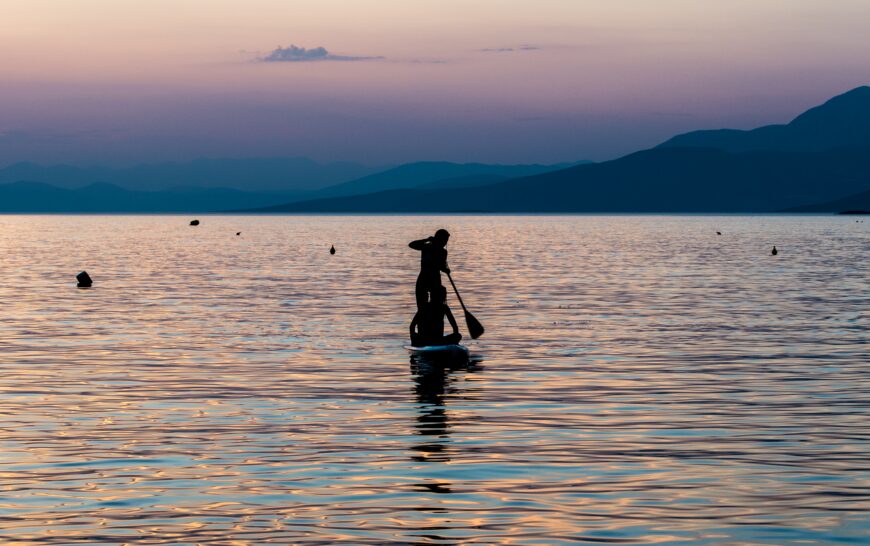
Stand up paddleboarding or SUP is the lockdown water sport everyone wants to have a go at and who can blame us? It’s a full core workout with the added benefit of not feeling like a workout (we’re sold), you’re free to explore the great outdoors, you can do it on just about any body of water – pa’s pond might be pushing it – and it’s perfect for all ages and skill levels.
With sunshine making a comeback, pootling along all the best coastlines, turquoise bays, rivers and lakes the UK has to offer is a glorious way to dive into the weekend, top up your tan and explore new places at the same time. This is multi-tasking at its best, only instead of compromising your mental health, it complements it.
If you’re a paddling newbie looking to test the waters, keep scrolling for your SUP 101.
The benefits of paddleboarding
From the shore, it’s very easy to assume that the SUP life is an easy life but don’t be fooled, those pros make it look effortless and once you’re on the water it is a top-notch form of cardio, especially if you’re racing friends or going at some speed to get your heart rate up. Hello abs of steel. The low impact sport is kind and gentle to your body, making it the perfect activity for anyone looking for something less strenuous than a couch to 5K.
The water has a relaxing effect on the mind and body
Beyond the endless physical benefits of moving your body, getting your exercise in the open air provides unrivalled mental clarity, too. The water has a relaxing effect on the mind and body, coupled with breathing in fresh air, getting a boost of vitamin D and socialising or making the most of the time to yourself, stand up paddling with nature as your backdrop is a great way to destress, switch off, boost your mood and work your entire body whilst you’re at it.
SUP requires mindfulness – it invites you to anchor yourself in the present moment, acknowledge the rhythm of the ocean and tune into your awareness. If your mind wanders at any point, it’s never too long before the water brings you right back to the board and the beauty that surrounds you. At a time when anxiety and emotional overwhelm is at an all-time high, it’s important to manage the pressures of daily life and find time to disconnect from social media and work. Taking the plunge is an excellent way to take charge of your mental health and grant your mind the sense of peace and space it needs to not only function but thrive.
Types of board
A stand up paddle board is much thicker and longer than your average surfboard. For newbies, the wider, thicker and longer the board, the more stability it has on the water and the easier it is to master the paddleboard basics.
Inflatable boards are typically less expensive than a standard hard paddleboard and are easily transportable
If you’re a first-time paddler, an All-Round SUP is great for all levels and conditions. Inflatable boards are typically less expensive than a standard / epoxy hard paddleboard and are easily transportable so if you’re planning to travel around a lot, the inflatable would be a great option for you. When it comes to performance, you can’t beat expoxy boards – particularly good for serious paddlers looking for increased speed and glide but more of an investment than your trusty inflatables.
For those who have some experience in SUP or other board sports and are looking for their next adrenalin adventure, you may want to explore the sport / performance board category.
There are also boards designed for particularly activities such as racing, yoga and fishing, so if you want a paddleboard for a specific use, this will narrow down your search.
Getting ready to SUP
First, you’ll need to adjust your paddle. The handle of your paddle should be able to reach the wrist – open the latch, put your arm above your head, bend at the elbow and reach for the handle to test it. Adjust your paddle height accordingly then close the latch.
Start on your knees
Once inside the water with your leash attached to your ankle, begin on your knees to get your balance under control and build confidence with your paddling before standing up.
Come to standing, placing your feet in the middle of the board with your chest forward and your eyes looking straight ahead at the horizon or something stable (not down at the water). Feet just under hip width apart, bend you knees slightly and engage your core. Bend forward slightly from your pelvis rather than your back and plunge your paddle into the water with the blade angled forward away from you to get the most power from your stroke. Pull the paddle back with your lower arm until you reach ankle-height, then reach forward and begin the movement again, switching sides every three to four strokes.
Some of the best SUP spots to get your paddle on:
Derwentwater, Lake District
It’ll come as no surprise that the Lakes are perhaps the best playground for stand up paddleboarding. Explore the secluded bays and river mouths and keep an eye out for the otters, kingfishers, ospreys and other wildlife. The world’s your oyster!
Windermere, Lake District
Another jewel in the crown of stand up paddleboarding in the Lake District. At 11 miles long and with easy access into the River Brathay, it’s the perfect spot to learn how to SUP.
Viking Bay, East Kent
Viking Bay is a beautiful spot to hop on your SUP and explore Broadstairs’ picturesque coastline. If you want to take to the water with confidence, you can even have a 2-hour group lesson with Kent Surf School for £35 or a private / couple’s session for £80.
The Norfolk Broads,
With 120 miles of navigable waterways, the Norfolk Broads are a haven for stand up paddleboarding. As part of the conservation and protection of the Broads, you will need to pay a short visit toll, which can be done online or at a number of outlets on the Broads here.
Cuckmere Haven, East Sussex
For a gentle and relaxing paddle, dip your toes in the River Cuckmere. The mouth of the river flows close to the Seven Sisters chalk cliffs, the perfect place to end your paddle, especially at sunset. You can also head towards the historical village of Alfriston and pull your board out at the footbridge behind the church. Book various classes with Buzz Active from taster sessions to cover the basics to SUP yoga, social evenings and breakfast paddles.
For more info and bookings click here:
https://www.buzzactive.org.uk/stand-up-paddleboarding-courses/
Paddington Basin, London
Paddleboarding in the big city, who knew? Paddington Basin is a cute little spot for exploring the canals and stopping at a waterside pub or café for a well-earned refreshment. You also pass Camden Town, ZSL London Zoo and Regent’s Park so it’s a great way to do some sightseeing, too. Pub-to-pub paddling is our cardio now. End of.
First timer SUP? Book an introductory session with Gutsy Girls to test the waters:
https://www.gutsygirls.co.uk/paddington-basin-standup-paddleboarding
Brighton, East Sussex
In the height of summer, Brighton beach is a 10/10 spot to take your SUP. Plus, we get a pretty decent sunset round here. Polish off your water sports with an ice cream on the beach and you’ll have a pretty big smile on your face. A word of warning: don’t be tempted to go and explore the West Pier ruins though, as there are many sharp obstructions under the water which would cause serious injury.
Stackpole Quay to Barafundle Bay, Pembrokeshire
For a particularly scenic paddle with wildlife aplenty, try Pembrokeshire’s spectacular National Park coastline. Join the Outer Reef Surf School on a guided paddle past the rugged cliffs and caves and with a bit of luck, you’ll spot some dolphins and porpoises along the way. Book ahead, here:
https://bookings.outerreefsurfschool.com/en/product/surf-lessons
Safety first:
• If you’re new to stand up paddleboarding, make sure you take a buddy along with you to keep an eye on you, or better yet, paddle at a busy spot with a lifeguard. It’s also a good idea with any watersports to let someone know exactly where you’re heading in case of emergencies.
• Always wear the ankle leash to connect you to the board so if you come off, the wind won’t blow your board away from you and you’ll be able to get back into shore.
• Look out for shallow rocks and reefs
• Off-shore wind can be dangerous – always paddle up-wind first so coming back will be easy.








